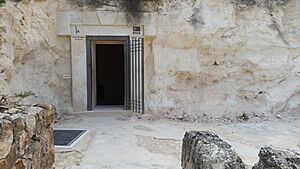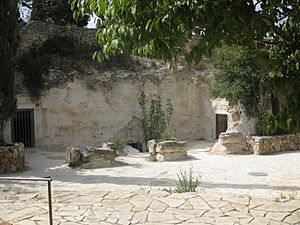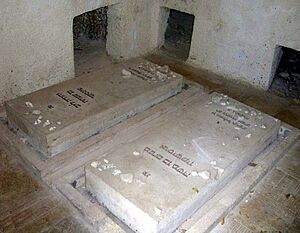Cave of Nicanor facts for kids
The Cave of Nicanor (pronounced ny-KAY-ner) is an old burial cave. You can find it on Mount Scopus in Jerusalem. Inside the cave, archaeologists found special stone boxes called ossuaries. These boxes held bones. One ossuary had writing on it that said "Nicanor the door maker."
This cave is now part of the National Botanic Garden of Israel. It is also on the campus of the Hebrew University of Jerusalem on Mount Scopus. Nicanor was from a rich Jewish family in Alexandria, Egypt. Ancient writings by the historian Josephus and in the Talmud mention him. They say Nicanor gave the bronze doors for the Women's Court in the Second Temple in Jerusalem. This important fact is also written in Greek on his ossuary. It is cool when archaeology confirms what old texts say!
Contents
Discovering the Cave
In October 1902, something exciting happened on Mount Scopus. A groundskeeper working for John Gray Hill found an old burial cave. It was just north of Gray Hill's winter home.
Gray Hill was not home at the time. So, the groundskeeper told the British Consul, John Dickson. Dickson's daughter, Gladys Dickson, was an amateur archaeologist. She went to look at the cave and what was inside. They found seven ossuaries. Six were plain, but one had writing in both Hebrew and Greek. The groundskeeper had already moved the ossuaries. So, Gladys could not see where they were originally placed.
Three days later, R. A. Stewart Macalister came to Jerusalem. He was an archaeologist working nearby. He checked the cave and the writing. A picture of the writing was sent to Charles Simon Clermont-Ganneau. The next year, two articles about the discovery were published. One was by Clermont-Ganneau about the writing. The other was Gladys Dickson's detailed report about the tomb. Gray Hill later gave Nicanor's ossuary to the Palestine Exploration Fund. They then sent it to the British Museum, where it is today.
What the Site Looks Like
There are two burial caves here. You can get to them from a rectangular courtyard carved into the rock. The way the cave is built and the items found inside show it was used around the middle of the first century CE. Later, during the Byzantine period, people still used the cave. This is known because Byzantine pottery was found. Also, two crosses are carved on the wall of the main room.
The cave with Nicanor's ossuary is a typical burial cave from the Second Temple period. It has four burial rooms. Each room has several places for burials. In the paths between the rooms, there are carved spots. These show that stone slabs decorated the entrances. This is a special feature unique to this cave. The second cave is smaller. It has only one burial room. It opens to the right, on the eastern side of the courtyard.
Nicanor's Special Ossuary
The British Museum says Nicanor's ossuary has two sets of writing. One is in Greek. It says, "Bones of the family of Nicanor the Alexandrian who made the gates." The other is in Hebrew. It simply says, "Nicanor Alexa."
Nicanor's ossuary has carved patterns on it. Its lid has rough red paint. The important writings are found at one end of the box.
| Original Greek and Hebrew | ΟCΤΑ ΝΟΡΟΣ ΠΟΙΗCΑΝΤΟΣ נקנר אלךסא |
| What it says (Transliteration) | Osta tōn tou Neika- noros Alexandreōs poiēsantos tas thyras nqnr ‘lks‘ |
| What it means (Translation) | Bones of those (meaning his family) of Nikanor of Alexandria, who made the gates. Nikanor Alexa |
Later Use of the Cave
In 1934, the remains of Leon Pinsker were moved here from Odessa. This happened because Menachem Ussishkin wanted to create a national burial place on Mount Scopus. However, Ussishkin was the only other person buried there. He died in 1941.
After Israel was founded in 1948, a new national leaders' burial plot was made. This new site was on Mount Herzl. This was partly because Mount Scopus became an area controlled by Jordan.
See also
 In Spanish: Cueva de Nicanor para niños
In Spanish: Cueva de Nicanor para niños
- Rock-cut tombs in Israel
- Archaeology of Israel





